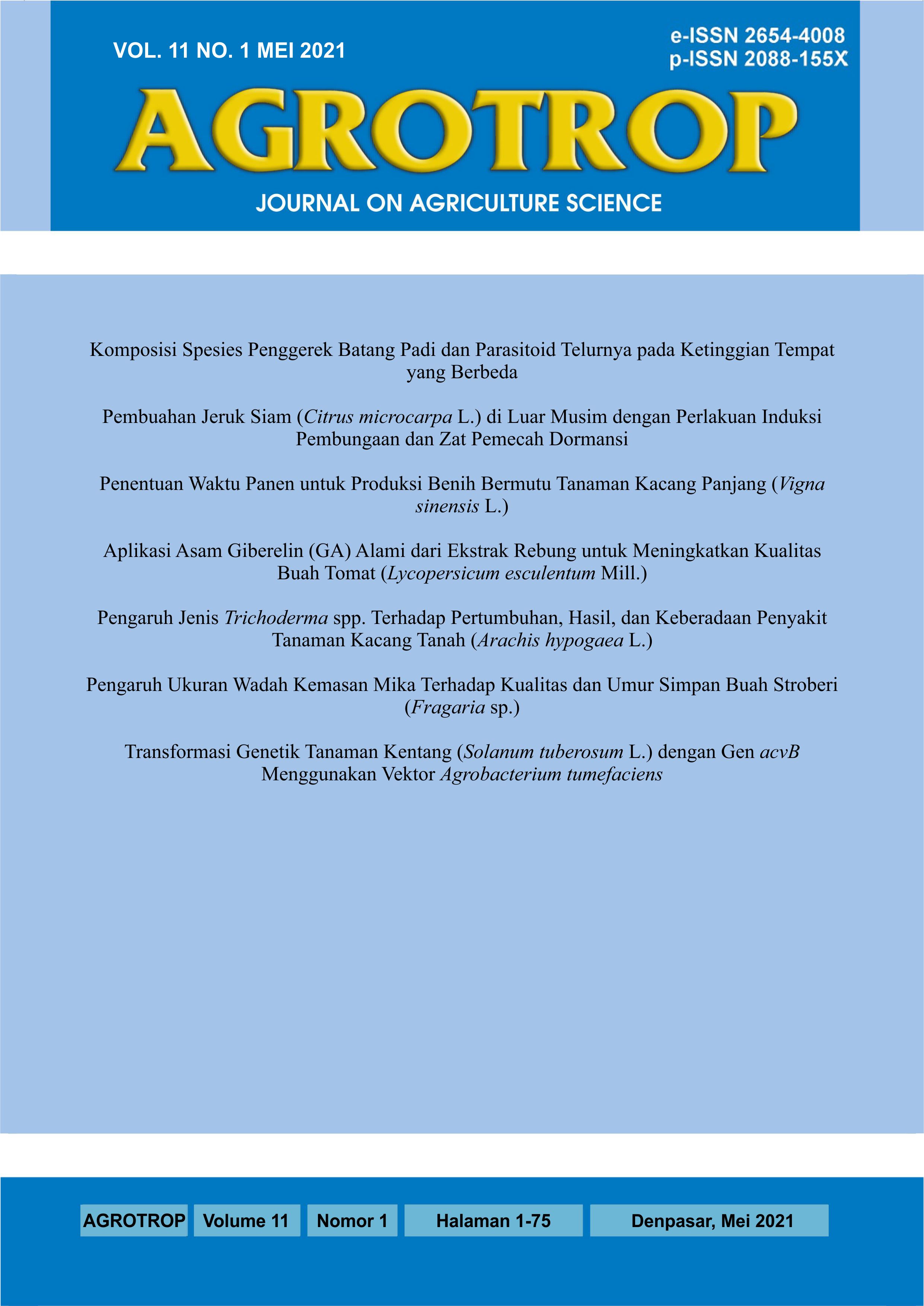Uji Pemangsaan dan Tanggap Fungsional Predator Chysoperla carnea Stephens (Neuroptera: Crysopidae) Terhadap Phenacoccus manihoti Matile-Ferrero (Hemiptera: Pseudococcidae)
Abstract
Predation and Functional Response Test of Predator Chysoperla carnea Stephens (Neuroptera: Crysopidae) Against Phenacoccus manihoti Matile-Ferrero (Hemiptera: Pseudococcidae). This study aims to evaluate the predatory capacity of C. carnea by measuring the rate of searching capacity and handling-time of one prey and its functional response to the population density of P. manihoti. The research was conducted at the Integrated Pest Management Laboratory (IPMLab), Faculty of Agriculture, Udayana University. The study was conducted from February to May 2019. Testing of functional responses used a randomized block design with 5 treatments (3, 6, 9, 12, 15 nymphs-3) each of which was repeated 10 times. The results showed that the prey searching-capacity when the population was low (3 nymphs-3) took longer (10.37 minutes), while when the population was high it took a short time (6.23 minutes). The length of time for handling one prey in the low population was 6.08 minutes, while in the high population it was 5.48 minutes. Predator C. carnea has a tpe-2 functional response to an increase in the population of P. manihoti nymphs with the equation Y = 4.32x / 1 + 1.973x (R2 = 0.980). The rate of predation increases sharply when the population of low increases, and decreases when the increase of prey population increases. C. carnea has the potential to be developed as a control agent for P. manihoti.
Downloads
References
Jones, D. B., Giles, K. L., Berberet, R. C., Royer, T. A., Elliott, N. C., & Payton, M. E. (2003). Functional Responses of an Introduced Parasitoid and an Indigenous Parasitoid on Greenbug at Four Temperatures. Environmental Entomology, 32(3), 425–432. https://doi.org/10.1603/0046-225X-32.3.425
Muniappan, R., Shepard, B. M., Watson, G. W., Carner, G. R., Rauf, A., Sartiami, D., Hidayat, P., Afun, J. V. K., Goergen, G., & Rahman, A. K. M. Z. (2009). New Records of Invasive Insects (Hemiptera: Sternorrhyncha) in Southeast Asia and West Africa. Journal of Agricultural and Urban Entomology, 26(4), 167–174. https://doi.org/10.3954/1523-5475-26.4.167
Nwanze, K. F. (1982). Relationships between cassava root yields and crop infestations by the mealybug, Phenacoccus manihoti. Tropical Pest Management, 28(1), 27–32. https://doi.org/10.1080/09670878209370669
Nwanze, K. F., Leuschner, K., & Ezumah, H. C. (1979). The Cassava Mealybug, Phenacoccus sp. in the Republic of Zaire. PANS, 25(2), 125–130. https://doi.org/10.1080/09670877909411685
Parsa, S., Kondo, T., & Winotai, A. (2012). The Cassava Mealybug (Phenacoccus manihoti) in Asia: First Records, Potential Distribution, and an Identification Key. PLoS ONE, 7(10), 47675. https://doi.org/10.1371/journal.pone.0047675
Pratiwi, N. P. E., Supartha, I. W., & Yuliadhi, K. A. (2018). Aktivitas Penerbangan dan Perkembangan Populasi Thrips parvispinus Karny (Thysanoptera: Thripidae) pada Tanaman Cabai Besar (Capsicum annuum L.). Agrotrop : Journal on Agriculture Science, 8(1), 29–37.
Purnomo, H. (2010). Pengantar Pengendalian Hayati. CV Andi Offset (Penerbit ANDI).
Supartha, I. W. (1991). Perilaku dan Parasitisme Lysiphlebus testacipes (Cresson) (Hymenoptera: Apidiidae) Terhadap Kutu Daun, Aphis craccivera Kock (Homoptera: aphididae) pada Empat Jenis Tanaman Kacang-Kacangan. Institut Pertanian Bogor.
Supartha, I. W., & Susila, I. W. (2001). Uji Pemangsaan Curinus coeruleus Mulsant (Coeloptera: Coccinellidae) pada Diaphorina citri Kuw. (Homoptera: Psyllidae) dan Heteropsylla cubana Crawford (Homoptera: Psyllidae). Agritrop, Journal on Agricultural Sciences, 20(1), 5–9.
Susilo, F. X. (2007). Pengendalian Hayati dengan Memberdayakan Musuh Alami. Graha Ilmu.
Wahyuni, S., Supartha, I. W., & Ubaidillah, R. (2017). Functional Response of Opius chromatomyiae Belokobylskij & Wharthon (Hymenoptera: Eulopidae) Parasitoid on Leaf Miner, Liriomyza Sativae Blanchard (Diptera: Agromyzidae). 5(1), 17–21.
Wahyuningsih, E. (2018). Biologi, Neraca Hayati dan Pemangsaan Cryptolaemus montrouzieri (Mulsant) (Coleoptera: Coccinellidae) pada Paracoccus marginatus. Institut Pertanian Bogor.
Wardani, N. (2015). Kutu Putih Ubi Kayu Phenacoccus manihoti Matile-Ferrero (Hemiptera: Pseudococcidae), Hama Invasif Baru di Indonesia. Institut Pertanian Bogor.











